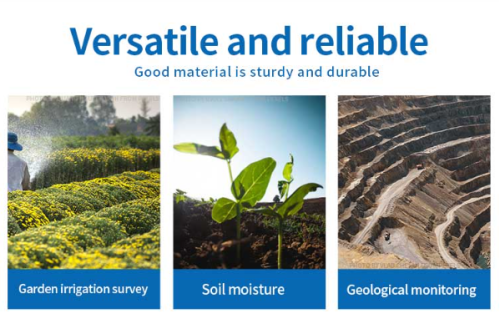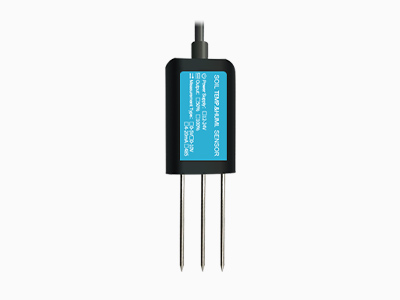I see soil moisture meters for sale all over the place and now there are numerous brands listed on Amazon. A lot of people must be buying them, but do they work? Are they accurate enough? Should you use soil moisture meters to determine when to water your plants?
Let’s have a close look at this garden device.

How Do Soil Moisture Meters Work?
This might surprise you but they don’t measure moisture. Instead they measure conductance which is a measure of the amount of electrical current flowing between two probes. Many soil moisture meters only have one probe but if you look at the tip there are two parts. The tip is one electrode and the shaft is another and they are separated by a piece of plastic.
Air is a poor conductor of electricity and gives a low conductance reading. Dry soil is mostly air. Water is a good conductor and so wet soil gives a higher conductance reading. Moisture meters use this concept to indirectly measure moisture of the soil.
The problem with conductance meters is that other things also affect conductance as you will see below. There are better quality moisture meters available but in this review I am focused on the garden sensor.
Readings From a Moisture Meter

Most of the current soil moisture meters for gardeners have a simple display with numbers from 1 to 10 and a needle that moves left and right to show you the value. These are not humidity numbers. They are just relative numbers that represent some degree of moisture.
The numbers might be color coded with red for dry, green for moist and blue for wet.
To take a measurement, stick the probe in the soil, wait a few seconds and take a reading between 1 and 10. Notice that the meter does not tell you if you should water the measured plant.
see what its Moisture Number is. Let’s say your plant is a 5. If the reading is wetter than 5, don’t water. If the reading is a 5 or drier, it is time to water. There are two significant problems with this method.
Plants Not On the List
If your plant is not on the list, you are out of luck. The best you can do is try and find another plant on the list that has the same watering needs. A new gardener won’t know this and an experienced gardener doesn’t need a moisture meter.
What About a Plant Collection?
If you have a number of different plants, you will need to either memorize their moisture number, or mark it somewhere so you can refer to it each time you water. Good luck with that!
Does the Soil Moisture Meter Work?
I wanted to see how well the meter works so I ran a number of tests. All of the following were done with a dual probe pH and moisture meter from Luster Leaf. The dual probe works just like a single probe meter except that one probe is for moisture and the other for pH.
Extreme Limits
Test: Measure moisture at the extremes. A dry pot of Promix with 15% added perlite had been sitting for over 4 weeks with no plant or watering. The wet pot was Promix that was watered well and allowed to sit in water overnight and then allowed to drain for 1 hour before measurements were taken.
Result: Dry pot gave a reading of 2.5, which is the same as when the meter is turned off or when it is measuring just air. It won’t go any lower than 2.5. The wet soil was a 9.
Conclusion: The 10 point range is actually a 6.5 point range on my unit, so it is less accurate than expected. It also means that plants with a moisture number of 1 or 2 will never get watered.
Soil Compaction
Test: Fill a pot with fresh moist Promix without packing it down. Measure moisture. Then pack it down hard and measure again.
Result: Un-packed soil gave a reading of 4 and packed was 5.5. The measurements were taken a few minutes apart to ensure no change in actual moisture amount.
Conclusion: The compacted soil has less air in it resulting in relatively more water, which increased the conductance (wetter reading). The moisture reading you get depends on how well you pack soil around the roots. This means a newly potted plant will measure drier than it will after a few months once the soil has settled, even if both pots have the same identical moisture level.
Soil Depth

Test: measure moisture at various depths in pots with plants.
Results: Some pots varied very little with depth, but other pots varied a lot – as much as 2 units from top to the bottom.
Conclusion: The probe does need to be inserted so that soil touches both electrodes which is about 2″ deep. Newly watered pots can have water sitting at the bottom of the pot so this should be avoided. The edge of the pot is drier then the center. It is important to measure at a consistent depth in all pots.
Effects of Fertilizer
Test: Fill two pots with fresh media and pack down normally. Measure both pots to make sure they give the same reading. Now water one with distilled water and the other with fertilized tap water. My water is fairly hard.
Results: There was a 1 unit difference between pots.
Conclusion: The salts in water increase conductivity. So both hard water and fertilizer should give a “wetter” reading. The Promix does have fertilizer in it so this may have kept the value for distilled water higher.
Moisture Meter vs Finger
Experienced gardeners use two methods to determine the need for water: finger or weight. The finger method is simple. Stick the finger in the soil and see if it is wet, moist or dry. Alternatively you can lift the pot. With a bit of practice this method, called hefting the pot, is quite accurate. Based on the weight you decide if it is time to water.
I went through my houseplant collection and did both a finger test and a meter test. Most of my plants are not on the plant list, so I don’t really know when to water using the meter. I do have some streptocarpus, which should be watered like an African violet which is a 3. Wet streptocarpus showed values in the 6 to 10 range. The one that was the wettest on the meter is almost ready for watering – maybe tomorrow. Others that showed a drier reading, are actually wetter. A couple that needed watering showed values of 5 so they are not ready for water according to the meter, but then my meter only shows a 3 in extremely dry conditions which would kill the plant.
My orchid media is very porous and the meter is useless in such media.
Problems with Moisture Meters
There are several problems with these meters.
Accuracy
There are too many variables involved: soil compaction, depth of reading, type of soil and limitations of the meter. There is no easy way to compensate for these.
Calibration
The units can’t be calibrated. In my case I am missing 2/3 of the range, making it even less accurate. A calibration feature might let you correct the readings for your type of soil.
Changes Over Time
Several things can affect the readings over time: corrosion of the probe, salt buildup in the media, fertilizer and soil compaction.
Soil Affects Conductivity
Conductivity is an indirect measurement of moisture and it’s affected by the type of soil. Clay and organic matter have a higher conductivity than silt and sand. That means that different gardens will give different readings even if they have the same amount of moisture. Different potting media will give different readings. A new plant from the nursery could give a very different reading than the same plant after you repot it because of a change in soil.
